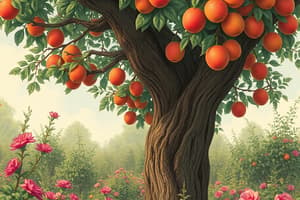Podcast
Questions and Answers
What is a key factor in selecting an apple variety?
What is a key factor in selecting an apple variety?
- Soil type
- Climate
- Tree size
- Desired use of the apples (correct)
What is the primary purpose of pruning apple trees?
What is the primary purpose of pruning apple trees?
- To change the tree's shape
- To promote healthy growth and air circulation (correct)
- To reduce tree height
- To increase fruit production
What is a common pest that spreads disease in apple trees?
What is a common pest that spreads disease in apple trees?
- Butterflies
- Codling moths
- Aphids (correct)
- Lady beetles
What is the recommended temperature for storing apples?
What is the recommended temperature for storing apples?
What is the purpose of using fine-mesh bags in apple production?
What is the purpose of using fine-mesh bags in apple production?
What is a key consideration in designing an apple orchard?
What is a key consideration in designing an apple orchard?
What is the main benefit of using a rectangular block orchard design?
What is the main benefit of using a rectangular block orchard design?
What is the purpose of fertilizing apple trees?
What is the purpose of fertilizing apple trees?
Study Notes
Apple Varieties
- Over 7,500 known varieties worldwide, each with unique characteristics
- Popular varieties:
- Red Delicious: sweet, tender, and crisp
- Granny Smith: green, tart, and great for cooking
- Fuji: sweet, crunchy, and disease-resistant
- Gala: sweet, aromatic, and great for snacking
- Variety selection depends on factors like climate, soil, and desired use (cooking, eating fresh, etc.)
Fruit Tree Care
- Planting:
- Choose a location with full sun and well-draining soil
- Space trees 20-30 feet apart for optimal growth
- Watering:
- Young trees need regular watering, especially during droughts
- Established trees require about 1 inch of water per week
- Pruning:
- Prune annually to promote healthy growth, fruiting, and air circulation
- Remove dead, diseased, or damaged branches
- Fertilization:
- Feed trees annually with a balanced fertilizer (10-10-10 NPK)
- Soil testing can help determine specific nutrient needs
Pest Management
- Common pests:
- Aphids: sap-sucking insects that spread disease
- Codling moths: larvae feed on fruit, causing damage and rot
- Apple maggots: larvae feed on fruit, causing damage and rot
- Integrated Pest Management (IPM) strategies:
- Monitor trees regularly for signs of pests
- Use physical barriers, like fine-mesh bags, to protect fruit
- Apply targeted pesticides or biological controls as needed
- Encourage beneficial insects, like lady beetles, to prey on pests
Harvesting Techniques
- Harvest apples when mature, as over-maturity can lead to spoilage
- Use gentle handling to avoid bruising or damaging fruit
- Harvesting methods:
- Hand-picking: suitable for small-scale orchards or specialty varieties
- Mechanical harvesting: efficient for large-scale commercial operations
- Storage techniques:
- Cool, dry storage (around 32°F and 60% humidity) to prolong shelf life
- Controlled atmosphere storage to maintain optimal ripeness
Orchard Design
- Considerations:
- Tree spacing and arrangement to optimize sunlight, air circulation, and pruning
- Soil type, slope, and drainage in orchard layout
- Access roads and pathways for easy maintenance and harvesting
- Orchard designs:
- Rectangular blocks: efficient use of space, easy pruning and harvesting
- Triangle or hexagonal layouts: promote air circulation, reduce disease spread
- Permaculture designs: incorporate diverse species, promote ecological balance
Apple Varieties
- Over 7,500 known apple varieties worldwide, each with unique characteristics
- Popular varieties include:
- Red Delicious: sweet, tender, and crisp
- Granny Smith: green, tart, and great for cooking
- Fuji: sweet, crunchy, and disease-resistant
- Gala: sweet, aromatic, and great for snacking
- Variety selection depends on factors like climate, soil, and desired use
Fruit Tree Care
- Planting considerations:
- Full sun is required
- Well-draining soil is essential
- Space trees 20-30 feet apart for optimal growth
- Watering requirements:
- Young trees need regular watering, especially during droughts
- Established trees require about 1 inch of water per week
- Pruning importance:
- Prune annually to promote healthy growth, fruiting, and air circulation
- Remove dead, diseased, or damaged branches
- Fertilization needs:
- Feed trees annually with a balanced fertilizer (10-10-10 NPK)
- Soil testing can help determine specific nutrient needs
Pest Management
- Common apple pests:
- Aphids: sap-sucking insects that spread disease
- Codling moths: larvae feed on fruit, causing damage and rot
- Apple maggots: larvae feed on fruit, causing damage and rot
- Integrated Pest Management (IPM) strategies:
- Monitor trees regularly for signs of pests
- Use physical barriers, like fine-mesh bags, to protect fruit
- Apply targeted pesticides or biological controls as needed
- Encourage beneficial insects, like lady beetles, to prey on pests
Harvesting Techniques
- Harvest apples when mature, as over-maturity can lead to spoilage
- Gentle handling is necessary to avoid bruising or damaging fruit
- Harvesting methods:
- Hand-picking: suitable for small-scale orchards or specialty varieties
- Mechanical harvesting: efficient for large-scale commercial operations
- Storage techniques:
- Cool, dry storage (around 32°F and 60% humidity) to prolong shelf life
- Controlled atmosphere storage to maintain optimal ripeness
Orchard Design
- Key considerations:
- Tree spacing and arrangement to optimize sunlight, air circulation, and pruning
- Soil type, slope, and drainage in orchard layout
- Access roads and pathways for easy maintenance and harvesting
- Popular orchard designs:
- Rectangular blocks: efficient use of space, easy pruning and harvesting
- Triangle or hexagonal layouts: promote air circulation, reduce disease spread
- Permaculture designs: incorporate diverse species, promote ecological balance
Studying That Suits You
Use AI to generate personalized quizzes and flashcards to suit your learning preferences.
Description
Explore the diverse world of apple varieties and learn about the key factors to consider when planting and caring for fruit trees




